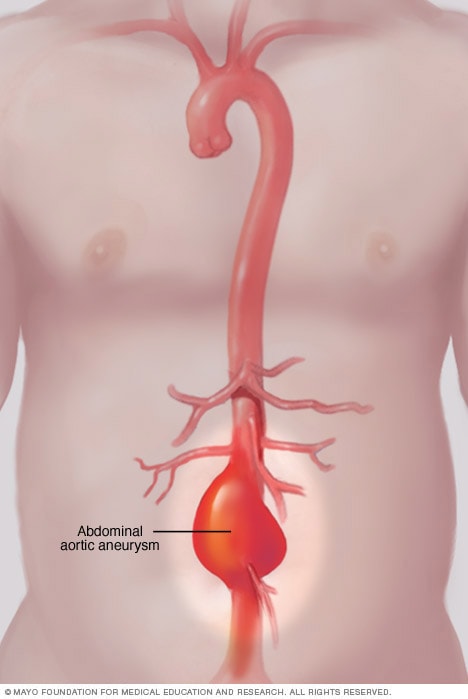Overview
Abdominal aortic aneurysm

Abdominal aortic aneurysm
An abdominal aortic aneurysm occurs when a lower part of the body's main artery, called the aorta, gets weak and bulges outward like a balloon.
An abdominal aortic aneurysm is an enlarged area in the lower part of the body's main artery, called the aorta. The aorta goes from the heart through the center of the chest and belly area, called the abdomen.
An abdominal aortic aneurysm that ruptures can cause life-threatening bleeding.
Treatment depends on how big the aneurysm is and how fast it's growing. Treatment may include regular health checkups and imaging tests to emergency surgery.
Symptoms
Abdominal aortic aneurysms often grow slowly. You might not notice any symptoms. This makes them hard to find. Many start small and stay small. Others get bigger over time, sometimes quickly. Some aneurysms never rupture.
If you have an abdominal aortic aneurysm that's getting bigger, symptoms might include:
- Deep, constant pain in the belly area or side of the belly.
- Back pain.
- A throbbing or pulsing feeling near the belly button.
When to see a doctor
If you have pain, especially if pain is sudden and very bad, get medical help right away.
Causes
An aneurysm can grow in any part of the aorta. Most aortic aneurysms happen in the part of the aorta that's in the belly area, called the abdomen.
Things that can cause an abdominal aortic aneurysm include:
- Hardening of the arteries, called atherosclerosis. Atherosclerosis occurs when fat and other substances build up in and on the artery walls.
- High blood pressure. High blood pressure can damage and weaken the aorta's walls.
- Blood vessel diseases. These diseases cause blood vessels to become swollen and irritated.
- Infection in the aorta. Rarely, germs can infect the aorta and cause an abdominal aortic aneurysm.
- Trauma. For example, being injured in a car accident can cause an abdominal aortic aneurysm.
Risk factors
Abdominal aortic aneurysm risk factors include:
- Tobacco use. Smoking is the strongest risk factor for aortic aneurysms. Smoking weakens the walls of blood vessels, including the aorta. This raises the risk of aortic aneurysm and aneurysm rupture. The longer and more you use tobacco, the greater the chances are of developing an aortic aneurysm. Men ages 65 to 75 who have ever smoked should have a one-time ultrasound to screen for an abdominal aortic aneurysm.
- Age. Abdominal aortic aneurysms occur most often in people age 65 and older.
- Sex. Men get abdominal aortic aneurysms much more often than women do.
- Being white. People who are white are at higher risk of abdominal aortic aneurysms.
- Family history. Having a family history of abdominal aortic aneurysms increases the risk of having the condition.
- Other aneurysms. Having an aneurysm in the aorta in the chest (thoracic aortic aneurysm) or in another large blood vessel, such as the artery behind the knee, might increase the risk of an abdominal aortic aneurysm.
If you're at risk of an aortic aneurysm, medicines may be given to lower blood pressure and relieve stress on weakened arteries.
Complications
Possible complications of abdominal aortic aneurysms include:
- Tears in one or more of the layers of the wall of the aorta, called an aortic dissection.
- Rupture of the aneurysm.
A rupture can cause life-threatening bleeding inside the body. In general, the larger the aneurysm and the faster it grows, the greater the risk of rupture.
Symptoms that an aortic aneurysm has ruptured can include:
- Sudden, very bad and long-lasting belly or back pain, which may feel like ripping or tearing.
- Low blood pressure.
- Fast pulse.
Aortic aneurysms also increase the risk of developing blood clots in the area. If a blood clot breaks loose, it can block a blood vessel elsewhere in the body. Symptoms of a blocked blood vessel may include pain or reduced blood flow to the legs, toes, kidneys or belly area.
Prevention
To prevent an abdominal aortic aneurysm or to keep one from worsening, take these steps:
- Don't smoke or use tobacco products. If you smoke or chew tobacco, quit. Also avoid secondhand smoke. If you need help quitting, talk to your healthcare team about strategies that may help.
- Eat a healthy diet. Choose a variety of fruits and vegetables, whole grains, chicken, fish, and low-fat dairy products. Avoid saturated and trans fats and limit salt.
- Keep your blood pressure and cholesterol under control. Take medicines as directed.
- Get regular exercise and stay active. Try to get at least 150 minutes a week of moderate aerobic activity. If you haven't been active, start slowly and build up. Talk to your healthcare team about what kinds of activities are right for you.